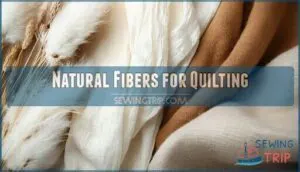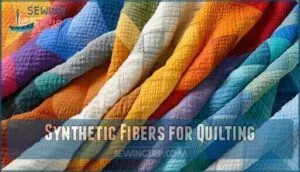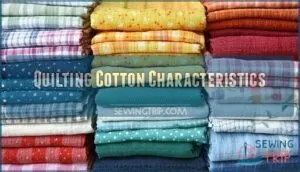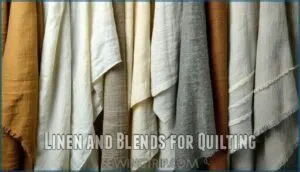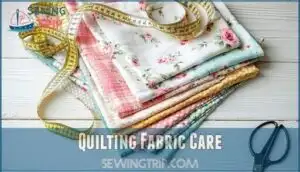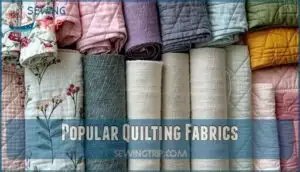This site is supported by our readers. We may earn a commission, at no cost to you, if you purchase through links.
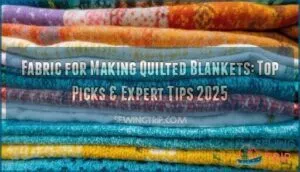
You’ll want quality quilting cotton with a tight weave that prevents batting from shifting through the fabric. Cotton flannel creates cozy winter quilts, while cotton sheeting works perfectly for backing.
Linen blends add texture, though they’re trickier for beginners. Pre-wash all fabrics to prevent shrinkage surprises later.
Stick with consistent fabric weights across your quilt layers for professional results. The right fabric choice determines whether your creation becomes a treasured heirloom or weekend disappointment.
Smart fabric selection involves more considerations than most quilters realize, including the importance of quality fabrics.
Table Of Contents
Key Takeaways
- Choose quilting cotton as your foundation – it’s durable, breathable, and handles intricate patterns while maintaining softness through countless washes.
- Pre-wash all fabrics before cutting – this prevents shrinkage surprises and color bleeding that’ll ruin your finished quilt, especially with flannel, which shrinks significantly.
- Keep fabric weights consistent across layers – mixing different weights creates puckers and pulls that make your quilt look unprofessional and affects how it drapes.
- Use 100% cotton for backing and wide-width fabric when possible – it eliminates seaming hassles and provides the breathability and durability you need for long-lasting quilts.
Quilting Fabric Types
When you’re choosing fabric for your quilted blankets, understanding the different fabric types will help you create projects that last for years.
Each fabric type brings unique characteristics that affect your quilt’s durability, warmth, and overall appearance, which is crucial for creating lasting projects.
Natural Fibers for Quilting
You’ll find natural fabrics offer exceptional durability and comfort for your quilting projects.
Cotton fabric provides outstanding Cotton Durability, making it the gold standard for quilting cotton.
Linen adds distinctive Linen Texture and strength to your quilts, while Silk Warmth creates luxurious, temperature-regulating layers.
Wool Insulation delivers unmatched coziness for winter quilts.
These natural fabrics resist pilling better than synthetics, ensuring your quilted blankets maintain their beauty over time.
Synthetic Fibers for Quilting
Synthetic fibers offer modern quilters practical advantages over natural materials.
Polyester dominates quilting, providing excellent polyester durability and affordable batting material for quilted blankets.
Microfiber softness mimics down while maintaining loft after washing.
Recycled fill supports eco-friendly projects without sacrificing performance.
Acrylic warmth substitutes for wool at lower costs.
These synthetic fibers resist allergens, mold, and pests.
Polyester demand soared past cotton in 2002, illustrating their market dominance.
Blends affordability makes polyester-cotton combinations popular for everyday blanket material, balancing comfort with easy care requirements, and providing excellent durability and affordable options, with recycled fill supporting eco-friendly projects.
Quilting Cotton Characteristics
Quilting cotton stands as the gold standard for quilt fabric, offering medium cotton weight that balances durability with workability.
This cotton fabric provides exceptional print absorption, making colors vibrant and crisp. Its hypoallergenic properties guarantee comfort for sensitive skin.
Leading quilting supplies brands like Moda, Robert Kaufman, Riley Blake, and Art Gallery Fabrics offer extensive brand variety in quilting fabrics, giving you countless design options for your quilting cotton projects.
A higher thread count impacts fabric smoothness and durability, guaranteeing lasting quilts with improved fabric smoothness and ensuring the quilts remain durable due to the higher thread count.
Linen and Blends for Quilting
Linen brings natural elegance to your quilt fabric collection with its distinctive texture and exceptional linen durability.
You’ll love how fabric blends like cotton-linen combinations offer the perfect balance – cotton’s softness meets linen’s strength and structure.
Different weave types create varied textures, from smooth plains to textured basketweaves.
Color options range from natural earth tones to vibrant dyes.
Heirloom quilts benefit from linen’s longevity, aging beautifully over decades while maintaining their charm and natural elegance.
Best Fabric for Quilt Backing
100% cotton stands as your go-to choice for quilt backing, offering unmatched durability and breathability. This reliable fabric softens beautifully with each wash while resisting pilling that plagues lesser materials.
When comparing cost and fabric width options, cotton bed sheets provide excellent value. Choose sheets with moderate thread count rather than high-count versions that fight your needle. Wide back fabric at 108 inches eliminates seaming headaches entirely.
Flannel backing creates cozy winter quilts but requires careful pre-washing due to significant shrinkage. Minky and cuddle fabrics deliver luxurious softness for baby quilts, though their stretch demands extra basting attention.
However, when using bedsheets, be aware of potential needle penetration issues due to their tight weave.
Color considerations matter too – quilting solids offer timeless appeal while pre-made backings with quilting patterns add visual interest. Muslin fabric works wonderfully for practice pieces. Fabric blends like cotton-poly combinations resist wrinkles but may pill over time.
Always pre-wash your chosen backing to prevent future disappointments.
Quilting Fabric Selection
Selecting the right fabric for your quilt requires balancing visual appeal with practical considerations like durability and ease of handling.
You’ll want to coordinate weight, texture, and color across your quilt top, binding, and backing to create a cohesive finished piece that performs well over time.
Choosing Fabric for Quilt Top
Five key factors will make or break your quilt top selection.
Consider print scale—large patterns work beautifully for simple quilting patterns, while small prints complement intricate fabric squares.
Your color palette should harmonize across fabric bundles.
Evaluate fabric durability and fiber content, prioritizing cotton for longevity.
Choosing the right quilt top material is essential for the overall quality.
Considering Fabric Weight and Texture
Weight and texture work hand-in-hand to create your quilted blanket’s personality.
Medium-weight quilting cotton offers ideal drape and density for most projects, while fabric hand feel determines comfort against skin.
Texture variety adds visual interest – mix smooth cottons with subtle texture fabrics for depth.
Consider weight distribution across layers; heavy fabrics may require adjusted layering techniques to prevent bunching and guarantee even quilting results.
Selecting Fabric for Quilt Binding
Binding fabric choice impacts your quilt’s final appearance and durability. You’ll want fabric that complements your quilt patterns while providing lasting edge protection.
Key binding considerations:
- Binding Fabric Width: Cut strips 2.25-2.5 inches wide for proper coverage and flexibility around quilt edges
- Bias vs. Straight: Choose bias-cut strips for curved edges and cornering techniques; straight grain works for simple rectangular quilts
- Machine vs. Hand: Machine binding offers speed with quilting notions, while hand-stitching provides invisible finishing
- Fabric Selection: Use patchwork fabric remnants, coordinate with quilt kits, or select contrasting colors for mitering binding effects
Selecting the right materials guarantees professional quilt finishing.
Coordinating Fabric for Quilt Layers
Your quilt’s three layers work together like a symphony orchestra – each part must complement the others.
Choose fabrics with similar weights to prevent pulling and puckering. Balance busy quilt patterns with solid or subtle backing fabric for quilts.
Match your flannel fabric top with flannel backing for consistent shrinkage. Consider print scale relationships – large prints pair beautifully with small ones.
Maintain visual balance through coordinated color harmony and varied fabric texture across all blanket layers.
Quilting Fabric Care
Proper fabric care guarantees your quilted blankets maintain their beauty and durability for years to come.
You’ll need to follow specific washing, drying, and storage techniques to prevent shrinkage, fading, and fabric damage, which helps ensure the durability of your quilted blankets.
Pre-Washing Fabric for Quilting
You’ll want to pre-wash your fabric before cutting to prevent shrinkage and color bleeding in your finished quilt.
Wash flannel fabric separately since it shrinks more than quilting cotton. Skip fabric softeners as they can affect batting adhesion.
Use cool water for pre cut fabric to maintain color integrity. Different quilting techniques require consistent fabric behavior, so pre-washing guarantees all materials respond uniformly during construction and future washing, ensuring uniform behavior and color integrity.
Drying and Ironing Quilting Fabric
After pre-washing, proper drying methods protect your fabric investment.
Air-dry quilting cotton flat or hang it to prevent stretching. Machine drying works but use low heat settings.
Skip fabric softeners—they create buildup that affects thread adhesion. For wrinkle prevention, remove fabric while slightly damp.
Steam ironing on medium temperature smooths stubborn creases without damaging fibers. Using starch and stabilizers can further improve fabric handling for quilting.
Preventing Fabric Shrinkage and Fading
Protect your quilting investment through smart fabric treatment and washing techniques.
Test colorfastness by dabbing wet cotton swabs on fabric corners before cutting.
Use cold water and gentle detergents to minimize fabric shrinkage and fading.
Add white vinegar or salt for natural dye setting.
Shield completed quilts from UV damage with proper storage.
Consider fabric stabilizers for delicate materials requiring extra fabric care during construction.
Storage and Handling of Quilting Fabric
Proper fabric storage extends your quilting materials’ lifespan substantially. Store fabric lengths in climate-controlled spaces with humidity control below 50%. An organized inventory system helps track your collection efficiently.
- Acid-free storage boxes prevent fabric deterioration and yellowing over time
Treat your fabric collection like a wine cellar—proper storage today preserves tomorrow’s quilting treasures.
- Folding methods should minimize creases – fold along lengthwise grain when possible
- Fabric rotation helps guarantee older pieces get used before newer acquisitions
- Fabric organization by color or project keeps your quilting fabrics accessible and protected
Popular Quilting Fabrics
You’ll find several fabric types work beautifully for quilted blankets, each offering unique benefits for different projects.
Cotton remains the quilting standard, while flannel, wool, and specialty fabrics like rayon create distinct textures and warmth levels perfect for specific seasons or decorative purposes.
Cotton Fabrics for Quilting
Cotton remains the gold standard for quilting fabric.
Cotton quilting fabric sets the benchmark – reliable, durable, and perfect for every skill level.
You’ll find quilting cotton offers medium weight, durability, and excellent printability.
Cotton Weave Types include percale and sateen, while Cotton Colorfastness guarantees your designs won’t fade.
Organic Cotton provides chemical-free options, and proper Cotton Thread Count affects drape and longevity.
Many crafters source quality quilting materials for their projects.
| Cotton Type | Best Use |
|---|---|
| Quilting Cotton | Quilt tops, blocks |
| Cotton Batting | Insulation layer |
| Organic Cotton | Eco-friendly projects |
| Cotton Blends | Added texture |
| Premium Cotton | Heirloom quilts |
Flannel and Fleece for Winter Quilts
When cooler weather arrives, you’ll want cozy texture that wraps your family in warmth.
Flannel offers superior layering warmth with its brushed cotton surface, while fleece provides lightweight insulation.
Choose flannel for traditional quilting with intricate stitch patterns, or select fleece for quick tie blankets.
Both fabrics work beautifully with rich color palettes.
Remember that flannel’s fabric weight requires pre-washing to prevent shrinkage in finished quilts, ensuring a long-lasting and cozy finished quilt.
Wool and Blends for Quilting
Wool offers exceptional warmth and insulation for your quilting projects.
This natural fiber provides hypoallergenic properties while creating luxurious, high-end quilts.
Felted wool resists fraying, making it perfect for appliqué work without raw edges.
Here are three key benefits of wool for quilting:
- Wool Warmth – Superior insulation properties keep you cozy during cold nights
- Blend Durability – Wool-cotton blends combine strength with softness for long-lasting quilts
- Care Considerations – Requires gentle washing and proper storage to maintain quality
When selecting woven fabric for your quilt, consider wool’s unique characteristics.
Felted wool works beautifully for wool appliqué techniques, while blended options offer easier maintenance.
Consider that fabric weight matters for the final drape of your quilt.
Check quilting tutorials for specific thread recommendations and quilting tips when working with these premium quilting materials.
Rayon and Silk Fabrics for Quilting
Rayon and silk bring elegance to quilting projects, though both fabric types require careful handling.
Rayon shrinkage concerns make pre-washing essential, while silk durability varies by weave type.
Printing rayon produces vibrant colors, and silk drape creates beautiful movement.
Blending fabrics with cotton stabilizes these delicate materials, and you’ll need gentle techniques when quilting these luxurious options.
Frequently Asked Questions (FAQs)
What is the best fabric for quilting blankets?
Like choosing the perfect thread for life’s tapestry, you’ll want quilting cotton as your go-to fabric. It’s durable, hypoallergenic, and handles those intricate patterns beautifully while staying soft against skin.
What is the best fabric for quilt backing?
You’ll want cotton fabrics like muslin or quilting cotton for backing since they’re breathable, durable, and easy to work with. Wide-width backing fabric reduces seams and creates smoother finished quilts.
What are the four kinds of fabric in quilting?
Consider Sarah choosing fabric for her first quilt – she’ll need four main types.
You’ll work with quilting cotton for the top, batting for insulation, backing fabric for the bottom, and binding strips to finish edges cleanly.
What is quilting fabric called?
Quilting fabric is commonly called "quilting cotton".
You’ll find this medium-weight, durable cotton fabric specifically designed for quilts at retailers like Mood Fabrics and Hobby Lobby, featuring brands like Moda and Riley Blake.
How much fabric is needed for different quilt sizes?
Lap quilts need 2-3 yards, twin quilts require 4-5 yards, queen quilts use 6-8 yards, and king quilts demand 8-10 yards of fabric, depending on your chosen pattern complexity.
What tools are essential for cutting quilting fabric?
Experienced quilters cut through an average of 200 fabric pieces per project. You’ll need a rotary cutter, self-healing mat, quilting ruler, and fabric scissors for precise cuts.
How do fabric grain directions affect quilt construction?
Fabric grain direction directly impacts your quilt’s stability and appearance. Cut pieces along the straight grain for structural integrity, avoiding bias cuts which stretch and distort your carefully planned design.
Can you mix different fabric weights in quilts?
Like oil and water that can’t blend smoothly, mixing fabric weights creates uneven tension.
That’ll cause your quilt to pucker, pull, and distort over time, making your finished piece look unprofessional.
Whats the difference between fat quarters and yardage?
Fat quarters measure 18" x 22" while yardage comes as continuous fabric by the yard (36" wide).
You’ll get more fabric per dollar with yardage, but fat quarters offer variety for smaller quilt pieces.
Conclusion
Successful quilters understand that fabric choice separates amateur projects from professional masterpieces.
Your selection of fabric for making quilted blankets directly impacts durability, comfort, and visual appeal.
Quality cotton remains the gold standard, offering reliability beginners can trust and versatility experts appreciate.
Pre-washing prevents disasters, while consistent fabric weights guarantee smooth construction.
Whether you’re creating your first baby quilt or hundredth heirloom piece, thoughtful fabric selection transforms simple materials into lasting treasures that withstand countless washes and years of love.
- https://madamsew.com/blogs/sewing-blog/beginner-guide-fabric-quilting
- https://www.loandbeholdstitchery.com/blogs/lo-and-behold/7-fabric-types-for-quilting-and-how-to-use-them-together-successfully
- https://www.dutchlabelshop.com/en_us/blog/best-fabrics-for-quilt-making/
- https://shahenaz.com/en-us/blogs/news/the-benefits-of-cotton-quilts-and-blankets-for-a-comfortable-winter-sleep
- https://www.reddit.com/r/quilting/comments/ysxdca/fabric_types/

